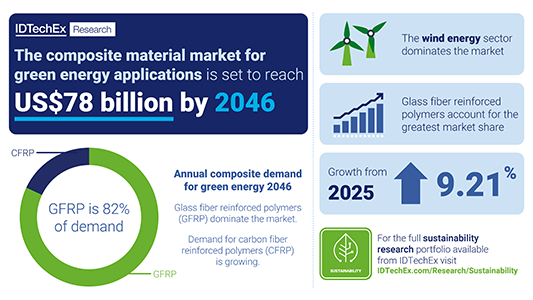Composite materials have long enabled high-performance, lightweight solutions across sectors such as aerospace, automotive, and construction. Now, these materials are becoming increasingly integral to the global energy transition. Under mounting pressure to meet decarbonization targets and sustainability commitments, industries are adopting fiber-reinforced polymer (FRP) composites, particularly glass and carbon fiber-based system, for use in next-generation renewable energy infrastructure. From wind turbine blades and EV battery enclosures to hydrogen storage vessels and tidal energy systems, composites are enhancing system performance, extending operational lifetimes, and supporting cost reductions.
In the new report, “Composite Materials for Green Energy Applications 2026–2046: Trends, Technologies & Sustainability Outlook”, IDTechEx presents a comprehensive evaluation of how composites are being deployed across the green energy sector. The report analyzes key market drivers, material innovations, sustainability challenges, and regulatory developments, while offering detailed 20-year forecasts. The global market for composite materials in green energy is expected to exceed US$78 billion by 2046.
Composites enabling renewable energy systems
The wind energy sector remains one of the most mature and expansive applications for composite materials, with FRPs playing a foundational role in the construction of turbine blades. Ongoing advancements in fiber reinforcements, resin chemistries, and manufacturing processes have allowed for the production of longer, more efficient blades, with turbine capacities now exceeding 15 MW. As global deployment of wind energy continues, demand for more durable and lightweight composite solutions will follow suit.
In the electric vehicle (EV) space, polymer composites are being used to address critical challenges around weight reduction. Automakers such as Volkswagen, Kia, and General Motors are incorporating GFRP and CFRP into battery enclosures to reduce mass and enhance drivetrain efficiency. However, issues such as thermal runaway prevention and electromagnetic interference (EMI) shielding remain key design considerations. This IDTechEx report explores how material developers are responding with advanced resin systems and novel fiber architectures.
Carbon fiber composites are also central to the growth of the hydrogen economy. Their exceptional strength-to-weight ratio and chemical resistance make them ideal for use in hydrogen storage tanks, particularly in the transition toward lighter and more durable Type V linerless pressure vessels. These systems offer substantial weight savings by eliminating metallic and polymer liners and are gaining traction in mobile hydrogen applications.
Composites are also being adopted across other renewable energy segments. In solar energy, GFRP is emerging as an alternative to aluminium for panel frames, offering lower weight and superior corrosion resistance. In marine energy, particularly tidal systems, FRPs provide excellent mechanical durability and resistance to harsh environmental conditions. Resins must display extreme resistance to saline corrosion, along with a high mechanical strength to mitigate cavitation risk. Geothermal applications are also exploring the use of composite piping and casing systems, offering long-term resistance to corrosive brines, where steel often fails. The thermal resistance of the materials does, however, currently limit application scope to low-enthalpy geothermal sources (<100°C).
Sustainability challenges and material circularity
Despite their performance advantages, thermoset-based FRP composites face significant challenges at end-of-life. The covalently crosslinked polymer networks in thermosetting resins are non-reprocessable, making recycling challenging, energy-intensive, and economically unattractive. With stricter environmental policies and growing waste volumes, there is increasing demand for circular material solutions.
In response, the industry is developing recyclable resin technologies, including the use of thermoplastics and most notably, vitrimers. Vitrimers, which feature dynamic covalent bonds, offer the mechanical benefits of thermosets with reprocessability under controlled conditions. Companies like Westlake Epoxy and Techstorm are advancing these systems for industrial use, with significant market focus paved towards the wind turbine industry.
Bio-based resins and natural fiber reinforcements are also gaining traction in applications that prioritize sustainability over maximum structural performance. Whilst moisture sensitivity and the lower mechanical strength of natural fibers prevent their use in high-load applications like wind blades, these materials are well suited for automotive interiors, consumer goods, and non-structural components, where environmental impact and aesthetics are prioritized.
Regulatory drivers for sustainable composite innovation
Government regulation is a major catalyst for material innovation. The wind and automotive sectors, which generate large volumes of composite waste, are facing increasing scrutiny. In Europe, countries such as Germany, France, and the Netherlands have already restricted the landfilling of wind turbine blades. Within the EU, the Waste Framework Directive requires member states to implement comprehensive waste reduction and resource recovery programs across product life cycles, impacting composite material suppliers.
As policy frameworks tighten, adoption of recyclable and bio-derived composite materials is likely to accelerate. Regulatory pressure is expected to influence both design choices and material selection, creating clear opportunities for sustainable alternatives to traditional thermosets.
Outlook: Performance, sustainability, and growth
The outlook for composite materials in green energy is shaped by two parallel imperatives: performance optimization and sustainability. From lightweighting and corrosion resistance to recyclability and lifecycle emissions, composite technologies are at the center of innovation across the energy transition. The need for stronger, lighter, and longer-lasting systems is rising across all major renewable energy technologies.
Through detailed analysis of fiber types, resin systems, sustainability trends, and policy developments, IDTechEx’s new report “Composite Materials for Green Energy Applications 2026–2046: Trends, Technologies & Sustainability Outlook”, delivers a comprehensive outlook for the composite materials market in green energy. As global industries shift to reach climate goals, composites will remain a cornerstone technology, supporting the deployment of clean energy systems that are efficient, scalable, and increasingly circular.For more information on this report, including downloadable sample pages, please visit www.IDTechEx.com/Composite, or for the full portfolio of related research available from IDTechEx, see www.IDTechEx.com.












